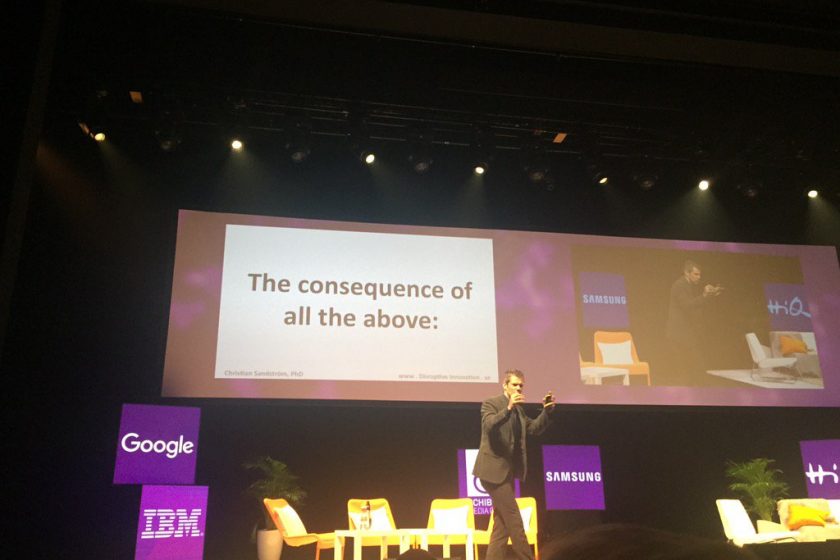A few weeks ago we attended Sime and listened to inter alia Christian Sandström, who made such a fantastic speech that we asked him right away to join our next VQ Forum as speaker.
he topic Associate Professor Christian Sandström, aka “Dr. Death”, presented at Sime, and also wrote his PhD thesis on, is disruptive innovation. The intriguing title of his speech was “Disruption seen with the eyes of the dead” on why disruption happens, why companies like Facit, Kodak and others were disrupted and died, and especially the leadership mistakes committed.
Christian Sandström’s research concerns technological change and the challenges they present for established firms. Among other things, he has studied the transition to digital photography, 3D Printing’s impact on established industries and how the sharing economy is affecting professions. Based on his research on disruptive technological change he has developed a new theory on the topic and has identified the following distinct disruptive patterns and associated problems:
1. Big companies think big, but everything new starts small
Big companies prioritize big markets. But disruptive new technology always starts off as something small, attracting new and/or small markets. Big companies therefore miss game changing developments before it is too late.
Kodak actually built the first digital camera already in 1975 and forecasted the digital development, but since the digital market remained so small up until it did not anymore, Kodak missed the change until it suddenly hit like a tsunami, altering the whole market and completely displacing the analogue technology.
In 2007, Nokia controlled 40 percent of the global cellphone industry. Since then, the company has collapsed and is now fighting to reinvent itself. In his research, Christian Sandström has pondered through Nokia’s quarterly presentation slides in the years 2007-2010, and found it noteworthy how little is said in these years concerning technological change and the ongoing shift from feature phones to smartphones (Apple’s iPhone was launched in 2007). Most of the information is related to market growth and gross margins, which were still good on the large markets. It took two years after the launch of the iPhone until Nokia finally announced that it was going to do something about its old software. In a digital world though, two years is a long time, and basically the ship had already sailed.
2. Competences are rendered obsolete
A disruptive innovation initially offers a lower performance according to what the mainstream market has historically demanded. At the same time it provides some new performance attributes, which in its turn makes it prosper in a different market. As it improves along the traditional performance parameters it eventually displaces the former technology. Thus, the competences of existing companies lose their value when disruptive technology provides new performance attributes.
In 1954 a transistor radio was launched by Sony. Until then radios had been large with a focus on sound quality and something of a luxury interior detail. But despite the bad sound quality, the focus on portability reached a new target group; teenagers, who could now bring music to the beach and other places away from their parents. Instead of adapting to the new portability demands, the existing radio producers responded by focusing even more on sound quality, thereby totally overshooting the needs of the market.
The same thing happened to Nokia. Instead of addressing the technological change and the emergence of smartphones, it kept on focusing on developing its existing software further and improving the quality to such an extent that the quality overshot the consumers’ willingness to pay for the improved technology.
3. Profitability control company strategies
A profitable market can be said to be in control, indirectly, of a company and its strategies. It is extremely difficult for an established company to change its strategy and shift focus from an existing profitable market to prioritize new, risky and not yet profitable, development projects. Often a disproportional amount of time is spent internally on defending new project instead of working with development activities.
Business Week 1997 about Kodak’s digitalization attempts: “The old-line manufacturing culture continues to impede Fisher’s efforts to turn Kodak into a high-tech growth company. Fisher has been able to change the culture at the very top. But he hasn’t been able to change the huge mass of middle managers, and they just don’t understand this [digital] world.”
Similarly, Hasselblad realized the need for already in 1985, but could not persuade the personnel to focus on a digitalization project when the development of the existing products kept the personnel so busy.
Robert Noyce 1978: “Time and time again the rapid growth of the market has found existing companies too busy expanding markets or product lines to which they were already committed to explore some of the more speculative new markets or technologies.”
4. Technology alters industry structure
Digitalisation changes industry structures and business models fundamentally, as it removes entry barriers and the need for distribution chains. With digitalization, producers can reach the end customers directly, with no middle men or specific distribution channels. Thereby the whole industry structure is disrupted. Digitalisation requires business models for small volumes and high profit margins, when value creation is decentralized. Existing companies risk being locked up in their established production architecture.
5. Why should you transform a market you created yourself?
Kodak used to be a verb, like Google. They were the market. Why should you (and how can you motivate yourself) to change a market that you created yourself?
Capitalism is about creating new markets or transforming an existing market. When you are the market, this is too personal and almost impossible to do.
Based on his research, Christian Sandström could conclude that most firms do not have a strategy for technological disruption. He has not been able to find in any company a clear decision point for not going for the digital market, it is almost always a non-decision to continue status quo that leads to paralysis and, eventually, the death of a company.
So mind the non-decisions! That is where it all goes wrong.

